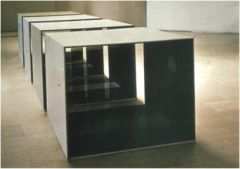Art Workers Coalition
Judd’s Specific Objects (1964)
specific objects
Process Art
site-specific art
skyspace
Minimalism
- Interested in art being a multitude of things
- Rejecting viewer. Lack of reference to natural world
- Extremely political
- Non-figurative sculptures
- Sculpture about being sculptural
Judd
Untitled, 1969
(St. Louis Art Museum)
- Didn’t like to use the word sculpture to describe his work
- Linear, hard edged.
- Lack of title rejects outside work.
- Not exactly perfect cubes but appear so
- Blue plexy glass. Industrial materials. Anodised aluminium. Industrially fabricated
- Wants installations to be called specific objects instead of sculptures
- Interconnected through light and reflections. Specific to location.
- Sculpture usually on plinth not on floor
- Hard edge interrupted by soft shadow as light changes
Untitled, 1969
- Brass, pink florescent flexy glass
- Hung by bracket and spaced at regular intervals
- Position in relation to your eye allows the boxes to change
- Calling attention to ceiling and floor
Serra
One Ton Prop (House of Cards), 1969
- 4 plates. 1 = 500lbs. Lead.
- 40 X 48 X 1”
- Worked at steel mill in college
- Held up by themselves. Physics
- Level of tension wrapped up in object. Threat.
Process Art
Hesse
Hang Up, 1966
- Hesse escapes Nazis during the war. Sent to an orphanage in Amsterdam but family collect her and her sister.
- 7ft x 6ft. 10ft projection.
- Stretcher wrapped in bedsheets and dyed.
- Process of healing. Hospital?
- “Idea pieces”. Conceptual idea that she is working out.
Untitled (Rope Piece), 1970
- Directions like LeWitt.
- Needed help installing it.
- No set shape. Loose hanging. Sense of movement.
- Fluidity. Chaos.
- Rope knotted and dipped in latex. Hung from ceiling and left to dry.
Earthworks
- Incorporating land
- Using land as a medium
Smithson
Spiral Jett, Great Salt Lake, Utah, 1969 – 70
- Black rock, crystal, earth.
- Platform. Earth pushed into lake which people can walk on.
- Man vs Nature
- Can construct all things with machines but nature can destroy them
Christo and Jeanne-Claude
Running Fence (California) 1972 – 76
- Federal and private land. Countryside.
- Result of negotiations.
- Free for public to see.
- Pair funded by selling sketches of works.
- $3.2 mil in 70s.
- 24.5 miles long. 18ft high. Cut across 2 counties. Ended in Pacific Ocean.
- Passed through middle of a town.
- Not lasting effects on environment
- Follows contours of land and wind.
The Gates (Project for Central Park, New York City), 1979 – 2005
- Lined paths with gates. 600 workers to install.
- Installation took 16 days. No environmental impact.
Installation Art
Turrell
The Meeting, 1986
- Skyspace
- Hole cut out of ceiling
- Alter perception of blue sky above
- Tones are matched to created certain experience
- Complimentary colours
- Closed when weather is bad
Gard Blue, 1968
Eliasson
The Weather Projection, 2003
- Perception of space.
- Illuminates with soft, hyper-articifcial sunlight
- Mirage
- Mirrored ceiling. Light bounces around the space.
- 200 sodium lamps
- How society perceives the weather.























































